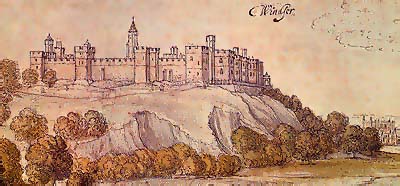
RBH Home
Maps & Travels
Articles
Legends
Towns & Villages
Castles & Houses
Churches
Biographies
Gentry
Family History
Odds & Ends
Mail David
Windsor Castle
Tudor Popularity
 The poet Earl of Surrey was much at
Windsor in his early life and was imprisoned there in 1546. In one of his
poems, he gives a description of the large green courts, the stately
seats, the secret groves, the wild forests and other delights of the
place. He was beheaded in 1547 for denying King Henry
VIII's supremacy in the church. Queen Jane Seymour was buried at
Windsor Castle with much pomp, a life-sized figure of the deceased was
upon the pall, with a rich crown of gold upon her head, the hair all
loose, a sceptre of gold in her right hand and adorned with finger-rings
and a necklace of gold and precious stones. In his will, Henry VIII
commanded that his body should be laid beside that of his "true and
loving wife, Queen Jane."
The poet Earl of Surrey was much at
Windsor in his early life and was imprisoned there in 1546. In one of his
poems, he gives a description of the large green courts, the stately
seats, the secret groves, the wild forests and other delights of the
place. He was beheaded in 1547 for denying King Henry
VIII's supremacy in the church. Queen Jane Seymour was buried at
Windsor Castle with much pomp, a life-sized figure of the deceased was
upon the pall, with a rich crown of gold upon her head, the hair all
loose, a sceptre of gold in her right hand and adorned with finger-rings
and a necklace of gold and precious stones. In his will, Henry VIII
commanded that his body should be laid beside that of his "true and
loving wife, Queen Jane."
Queen Elizabeth was very fond of Windsor Castle, and sometimes remained
all the autumn and over Christmas. Between 1569 and 1577, more than £1,000
a year was spent on improvements, which, remembering Elizabeth's
parsimony, is very surprising. It is said that Elizabeth desired to see
"Falstaff in love," and therefore it was that Shakespeare
resurrected the Queen's favourite character from "Henry
IV" and laid the scene of the "Merry Wives" at
Windsor. As Elizabeth was very fond of riding, many a gay cavalcade of
beautiful ladies and gallant gentlemen must have issued from the gates of
Windsor, whilst many a magnificent pageant must have been held and many
must have been the love scenes enacted here, during her long reign.
There are several old descriptions of the castle at this period still
extant and, among the Harleian MSS, is one generally attributed to the
London historian, Stowe. "Upon the north side and outer part of which
[describing the Terrace] lodgings also, between the same and the
brow or fall of the hill which is very steep and pitched, is an excellent
walk or bay, running all along the said buildings and the side of the
castle borne up and sustained with arches and buttresses of stone and
timber railed breast high which is in length 360 paces, and in breadth 7,
of such and excellent grace to the beholders and passers by lying open to
the sight even afar off; that the state lines, pleasure, beauty, and the
use thereof seemeth to contend one with another which of them should have
the superiority."
Part
6: Parliamentary Stronghold
Edited from PH Ditchfield's "Bygone
Berkshire" (1896)
